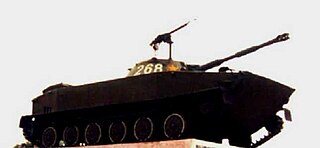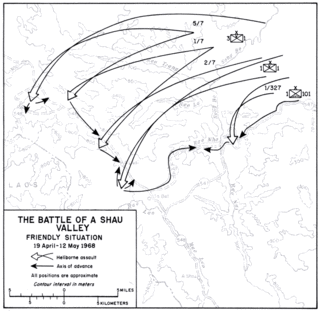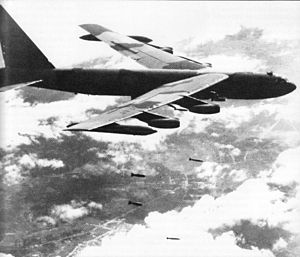
The Tet Offensive was a major escalation and one of the largest military campaigns of the Vietnam War. The Viet Cong (VC) and North Vietnamese People's Army of Vietnam (PAVN) launched a surprise attack on 30 January 1968 against the forces of the South Vietnamese Army of the Republic of Vietnam (ARVN), the United States Armed Forces and their allies. It was a campaign of surprise attacks against military and civilian command and control centers throughout South Vietnam. The name is the truncated version of the Lunar New Year festival name in Vietnamese, Tết Nguyên Đán, with the offense chosen during a holiday period as most ARVN personnel were on leave. The purpose of the wide-scale offensive by the Hanoi Politburo was to trigger political instability in a belief that mass armed assault on urban centers would trigger defections and rebellions.

The Battle of Khe Sanh was conducted in the Khe Sanh area of northwestern Quảng Trị Province, Republic of Vietnam, during the Vietnam War. The main US forces defending Khe Sanh Combat Base (KSCB) were two regiments of the United States Marine Corps supported by elements from the United States Army and the United States Air Force (USAF), as well as a small number of Army of the Republic of Vietnam (ARVN) troops. These were pitted against two to three divisional-size elements of the North Vietnamese People's Army of Vietnam (PAVN).

Operation Commando Hunt was a covert U.S. Seventh Air Force and U.S. Navy Task Force 77 aerial interdiction campaign that took place during the Vietnam War. The operation began on 15 November 1968 and ended on 29 March 1972. The objective of the campaign was to prevent the transit of People's Army of Vietnam (PAVN) personnel and supplies on the logistical corridor known as the Ho Chi Minh Trail that ran from southwestern North Vietnam through the southeastern portion of the Kingdom of Laos and into South Vietnam.

The Battle of Lang Vei began on the evening of 6 February 1968 and concluded during the early hours of 7 February, in Quảng Trị Province, South Vietnam. Towards the end of 1967, the 198th Tank Battalion of the People's Army of Vietnam's (PAVN) 202nd Armored Regiment received instructions from the North Vietnamese Ministry of Defense to reinforce the 304th Division as part of the Route 9–Khe Sanh Campaign. After an arduous journey down the Ho Chi Minh trail in January 1968, the 198th Tank Battalion linked up with the 304th Division for an offensive along Highway 9, which stretched from the Laotian border through to Quảng Trị Province. On 23 January, the 24th Regiment attacked the small Laotian outpost at Bane Houei Sane, under the control of the Royal Laos Army BV-33 "Elephant" Battalion. In that battle, the 198th Tank Battalion failed to reach the battle on time because its crews struggled to navigate their tanks through the rough local terrain. However, as soon as the PT-76 tanks of the 198th Tank Battalion turned up at Bane Houei Sane, the Laotian soldiers and their families retreated into South Vietnam.
Operation Igloo White was a covert United States joint military electronic warfare operation conducted from late January 1968 until February 1973, during the Vietnam War. These missions were carried out by the 553rd Reconnaissance Wing, a U.S. Air Force unit flying modified EC-121R Warning Star aircraft, and VO-67, a specialized U.S. Navy unit flying highly modified OP-2E Neptune aircraft. This state-of-the-art operation utilized electronic sensors, computers, and communications relay aircraft in an attempt to automate intelligence collection. The system would then assist in the direction of strike aircraft to their targets. The objective of those attacks was the logistical system of the People's Army of Vietnam (PAVN) that snaked through southeastern Laos and was known as the Ho Chi Minh Trail.

Operation Lam Son 719 or 9th Route – Southern Laos Campaign was a limited-objective offensive campaign conducted in the southeastern portion of the Kingdom of Laos. The campaign was carried out by the armed forces of South Vietnam between 8 February and 25 March 1971, during the Vietnam War. The United States provided logistical, aerial and artillery support for the operation, but its ground forces were prohibited by law from entering Laotian territory. The objective of the campaign was the disruption of a possible future offensive by the People's Army of Vietnam (PAVN), whose logistical system within Laos was known as the Ho Chi Minh Trail.

Operation Barrel Roll was a covert interdiction and close air support campaign conducted in the Kingdom of Laos by the United States military between 5 March 1964 and 29 March 1973, concurrent with the Vietnam War. During the operation, U.S. Air Force 2nd Air Division and U.S. Navy Task Force 77 dropped 260 million bombs on Laos.

The Hill Fights took place during the Vietnam War between the People's Army of Vietnam (PAVN) 325C Division and United States Marines on several hill masses north of the Khe Sanh Combat Base in northwest Quảng Trị Province.

The involvement of the United States in the Vietnam War began in the 1950s and greatly escalated in 1965 until its withdrawal in 1973. The U.S. military presence in Vietnam peaked in April 1969, with 543,000 military personnel stationed in the country. By the end of the U.S. involvement, more than 3.1 million Americans had been stationed in Vietnam, and 58,279 had been killed.

The Battle of Kham Duc was a major battle of the Vietnam War. The event occurred in Khâm Đức, now district capital of Khâm Đức District, then in Quảng Tín Province, from 10–12 May 1968. During the Tet Offensive of 1968, the People's Army of Vietnam (PAVN) 2nd Division tried to capture Đà Nẵng, but they were defeated in the Battle of Lo Giang by elements of the U.S. 1st Marine Division and the 23rd Infantry Division. PAVN General Chu Huy Mân disengaged from the fight on the outskirts of the city, and pulled the 2nd Division into the mountains to rest, rebuild, and prepare for the next major operation. The US and allied defenders of the Special Forces camp at Khâm Đức, a small district in the north of Quảng Tín, were chosen as the next target for the 2nd Division. Although the Special Forces camp had never been an obstacle to the constant infiltration of PAVN troops around it, the North Vietnamese hoped to attract major US reinforcements away from the lowland populated areas, kill or capture them and film the battle, presumably to make it look like a US Điện Biên Phủ on the eve of the 1st Paris peace conference.

Khe Sanh Combat Base was a United States Marine Corps outpost south of the Vietnamese Demilitarized Zone (DMZ) used during the Vietnam War.
The Battle of Ban Houei Sane took place during the Vietnam War, beginning on the night of 23 January 1968, when the 24th Regiment of the People's Army of Vietnam (PAVN) 304th Division overran the small Royal Lao Army outpost at Ban Houei Sane. The fighting at Ban Houei Sane was one in a series of battles fought between North Vietnamese and Allied forces during the Tet Offensive. The small outpost, defended by the 700 man Bataillon Volontaire (BV-33), was attacked and overwhelmed by the vastly superior PAVN and their PT-76 light tanks. The failure of BV-33 to defend their outpost at Ban Houei Sane had negative consequences only a few weeks later, when the PAVN struck again at Lang Vei.

Operation Delaware/Operation Lam Son 216 was a joint military operation launched during the Vietnam War. It began on 19 April 1968, with troops from the United States and the Army of the Republic of Vietnam (ARVN) moving into the A Sầu Valley. The A Sầu Valley was a vital corridor for moving military supplies coming from the Ho Chi Minh Trail and was used by the People's Army of Vietnam (PAVN) as a staging area for numerous attacks in northern I Corps. Other than small, special operations reconnaissance patrols, American and South Vietnamese forces had not been present in the region since the Battle of A Shau in March 1966, when a U.S. Special Forces camp located there was overrun.

Forward air controllers (FACs) played a significant part in the Vietnam War from the very start. Largely relegated to airborne duty by the constraints of jungled terrain, FACs began operations as early as 1962. Using makeshift propeller-driven aircraft and inadequate radio nets, they became so essential to air operations that the overall need for FACs would not be completely satisfied until 1969. The FAC's expertise as an air strike controller also made him an intelligence source, munitions expert, communication specialist, and above all, the on-scene commander of the strike forces and the start of any subsequent combat search and rescue if necessary.

The year 1968 saw major developments in the Vietnam War. The military operations started with an attack on a US base by the North Vietnamese People's Army of Vietnam (PAVN) and the Viet Cong (VC) on January 1, ending a truce declared by the Pope and agreed upon by all sides. At the end of January, the PAVN and VC launched the Tet Offensive.
The 304 Division is an infantry division of the People's Army of Vietnam (PAVN). It was established in January 1950 at Thanh Hoa.
The Battle of Signal Hill was a company size engagement between members of Company E, 52nd Infantry (LRP) long-range reconnaissance patrol of the 1st Cavalry Division (Airmobile) and the People's Army of Vietnam (PAVN) from 19 to 21 April 1968 during Operation Delaware. Signal Hill was the name given to the peak of Dong Re Lao Mountain, a densely forested 4,878-foot (1,487 m) mountain in the A Sầu Valley. The strategic location made it an ideal communication and fire support site, vital to the success of Operation Delaware.

Operation Robin was a U.S. Marine Corps operation that took place southeast of Khe Sanh, Quảng Trị Province from 2–19 June 1968.
Operation Scotland II was a U.S. Marine Corps security operation that took place in northwest Quảng Trị Province from 15 April 1968 to 28 February 1969.

Operation Crockett was an operation during the Vietnam War conducted by the United States Marine Corps against People's Army of Vietnam (PAVN) forces around Khe Sanh Combat Base in northwest Quảng Trị Province that took place from 13 May to 16 July 1967. The PAVN tested U.S. defenses, forcing the Marines to deploy additional forces to the area, following which the PAVN disengaged but did not withdraw from the area. The operation resulted in 111 PAVN killed and one captured for Marine losses of 34 killed. The operation was immediately followed by Operation Ardmore, an ongoing security operation.

















